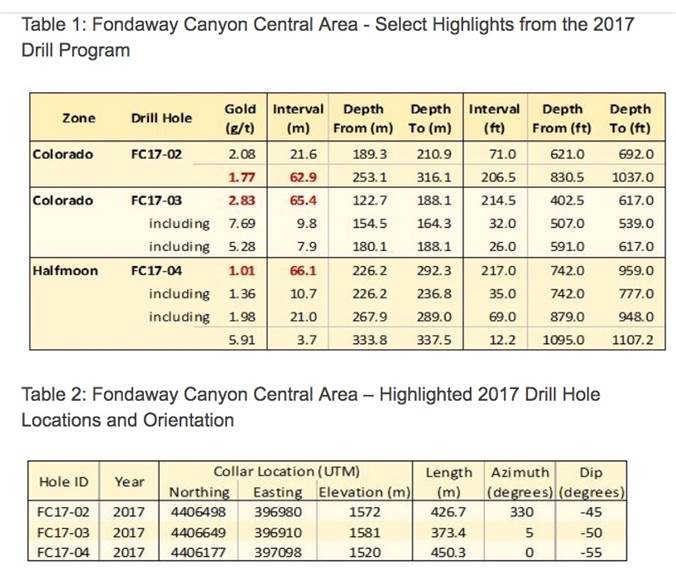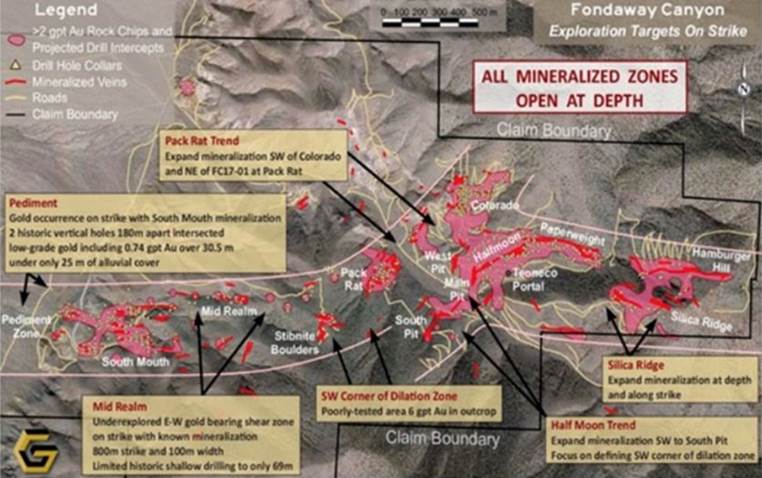Getchell Gold to test geological model in August drill program
- Home
- Articles
- Uncategorized
- Getchell Gold to test geological model in August drill program

2020.08.12
Getchell Gold (CSE:GTCH) hasn’t let the pandemic impede plans to explore Fondaway Canyon, its flagship gold project in Nevada.
In a recent Ahead of the Herd video, President Mike Sieb explains how covid-19 has actually allowed the company to step back and evaluate the project as a whole, rather than focusing on its component parts as previous operators have done.
Gold was first discovered in Fondaway Canyon in 1977 and over the intervening 40+ years has been the subject of multiple exploration campaigns totaling 735 reverse circulation and core drill holes, and small-scale open pit mining of the oxidized zone at surface.
As Sieb notes in the video, five decades of multiple operators have left a voluminous data set – with historical exploration equating to roughly 25 million dollars. “That’s quite a healthy inheritance.”
Over the last few months, Getchell’s technical team has conducted a comprehensive interpretation of the historical data set to develop a newly refined geological and gold mineralizing model, and design a first-phase drill program.
“We’re creating a new geological model that is quite compelling,” says Sieb.
To help shareholders to visualize the mineralized domains used for exploration targeting and mineral inventory, Getchell created an animated video, using a 3D exploration modeling package. Access the Fondaway Canyon Gold Project video through this link
The exploration model in the video is constructed from drill hole sample intervals and shows two mineralized domains: a higher-grade gold domain based on drill intercepts grading >1 g/t Au; and an enveloping lower-grade domain based on drill intercepts grading >0.25 g/t Au.
Significant intervals within a large historic resource, detailed in a May 6, 2020 news release, include 2.83 g/t Au over 65.4m (Hole FC17-03) and 1.77 g/t Au over 62.9m (Hole FC17-02) at the Colorado zone; and 1.01 g/t Au over 66.1m (Hole FC17-04) at the Halfmoon zone.
A 2017 technical report denotes 409,000 oz of indicated resources grading 6.18 grams per tonne, and 660,000 oz inferred grading 6.4 g/t, for a combined 1.1 million ounces.
The 3.5-km-long gold mineralized trend remains open along strike and at depth.

Mike Sieb does a great job in the AOTH video of explaining the new model Getchell has put together and will be testing in its 2020 drill program, expected to start at the end of August.
Past geological models at Fondaway Canyon focused on vertical gold shoots thought to be conduits for the mineralization. The new model supports a second direction for gold emplacement, one where the gold is trapped underneath “sills”. A sill is a tabular sheet that has intruded between older layers of sedimentary rock, beds of volcanic lava or tuff, or along the direction of foliation in metamorphic rock.
Getchell has confirmed this gold emplacement is broader than they expected.
“There’s going to be evident plumes. And you can see it by the zones that have been focused on in the past, where you come across a zone where there’s a high density of mineralization,” Sieb explained. [what we at AOTH have referred to as “vein swarms” trending east to west, shown in red in the map below]

“That’s because it’s a juncture of those structures that are controlling the gold emplacement,” Sieb continued. “We’ve now identified what those structures are, so we can spot our future exploration, to tap into those areas and start connecting the dots, hopefully adding more gold to the model.”
Mineralization
Getchell’s job is to figure out whether its project fits the picture of a big “Carlin-style” Nevada gold system, and if it does, how do they find the pathways that carried the gold from a presumably much larger deposit, below the near-surface mineralization?
Equally important: Where is/ are the intrusive(s)? ie., the igneous rock potentially hosting hundreds of meters of mineralization. The trick is finding the main conduit hosting the mineralizing fluids to depth, or on strike which may have soaked into the right age of sandstone along their path. It is likely going to be parallel to one of either the east-west conduit from the Pediment Zone to Hamburger Hill, or the 60-degree offset from the Stibnite Boulders zone to the Colorado zone.
That’s why Getchell needs to chase the system at depth and along strike.
From the 2017 technical report: Mineralization is characteristically a gold/silver ratio of greater than 1:1 and is associated with the sulfide minerals of pyrite, arsenopyrite, and stibnite with lesser amounts of chalcopyrite, tennantite/tetrahedrite, sphalerite, and galena. Gold/electrum is mainly identified as inclusions within pyrite of hydrothermal wall rock replacement and silica/carbonate-rich fracture-fill/breccia cement assemblages, in places in close spatial association and intergrowths with chalcopyrite, sulphosalt minerals and arsenopyrite.
Shale and ardillite are fine-grained sedimentary rocks that are tightly packed together – fluid doesn’t move through them. Sometimes units of shale lie overtop of sandstone, capping the fluids underneath. If these fluids sat for a long time in porous sandstone, there could be a monster Carlin-style deposit lurking underneath the vein swarms.
If that’s the case at Fondaway, and there is gold in the sandstone, how did it get up to the veins near surface? This happens wherever there is a break in the shale, allowing the trapped gold-bearing fluids to flow into the upper stratigraphy. The gold is deposited into rock fractures, becoming veins.
There are two ways forward with the veins at Fondaway Canyon. One is to follow them to depth and see whether the mineralization becomes stronger in more cohesive structures. A second way is to investigate whether the veins change composition as they snake into different geological packages. Ideally they get into even more receptive host rock, ie., a district-scale, Carlin-style gold deposit.
The fact that Fondaway Canyon has stibnite boulders on the property is very encouraging. Most Carlin-style environments are gold, arsenic and antimony. Numerous zones at Fondaway have arsenic – the Pack Rat zone has the most. The combination of arsenic and antimony (stibnite) is a strong indicator of a big system – one that has the right temperature, the right pressure and the right chemistry to be a Carlin look-alike.
One thing is for certain: Fondaway Canyon is a vein system, but with the amount of fluids it must have taken to fill all these cracks, if the right age of calcareous sediments can be identified, that are even better host rocks than the veins, we could be looking at a multi million oz deposit!
Mike Sieb concludes,
“The extensive near-surface gold mineralization as depicted by the exploration model in the video is quite compelling and reflects our high expectations for the Fondaway Canyon Gold Project. We look forward to the much-anticipated drill program scheduled to commence late this month that will test the further extent of the gold mineralization.”
Richard (Rick) Mills
aheadoftheherd.com
subscribe to my free newsletter
Ahead of the Herd Facebook
Legal Notice / Disclaimer
Ahead of the Herd newsletter, aheadoftheherd.com, hereafter known as AOTH.
Please read the entire Disclaimer carefully before you use this website or read the newsletter. If you do not agree to all the AOTH/Richard Mills Disclaimer, do not access/read this website/newsletter/article, or any of its pages. By reading/using this AOTH/Richard Mills website/newsletter/article, and whether or not you actually read this Disclaimer, you are deemed to have accepted it.
Any AOTH/Richard Mills document is not, and should not be, construed as an offer to sell or the solicitation of an offer to purchase or subscribe for any investment.
AOTH/Richard Mills has based this document on information obtained from sources he believes to be reliable but which has not been independently verified. AOTH/Richard Mills makes no guarantee, representation or warranty and accepts no responsibility or liability as to its accuracy or completeness. Expressions of opinion are those of AOTH/Richard Mills only and are subject to change without notice. AOTH/Richard Mills assumes no warranty, liability or guarantee for the current relevance, correctness or completeness of any information provided within this Report and will not be held liable for the consequence of reliance upon any opinion or statement contained herein or any omission. Furthermore, AOTH/Richard Mills assumes no liability for any direct or indirect loss or damage or, in particular, for lost profit, which you may incur as a result of the use and existence of the information provided within this AOTH/Richard Mills Report.
AOTH/Richard Mills is not a registered broker/financial advisor and does not hold any licenses. These are solely personal thoughts and opinions about finance and/or investments – no information posted on this site is to be considered investment advice or a recommendation to do anything involving finance or money aside from performing your own due diligence and consulting with your personal registered broker/financial advisor. You agree that by reading AOTH/Richard Mills articles, you are acting at your OWN RISK. In no event should AOTH/Richard Mills liable for any direct or indirect trading losses caused by any information contained in AOTH/Richard Mills articles. Information in AOTH/Richard Mills articles is not an offer to sell or a solicitation of an offer to buy any security. AOTH/Richard Mills is not suggesting the transacting of any financial instruments but does suggest consulting your own registered broker/financial advisor with regards to any such transactions
Richard owns shares of Getchell Gold (CSE:GTCH). GTCH is a paid advertiser on his site aheadoftheherd.com
Legal Notice / Disclaimer
Ahead of the Herd newsletter, aheadoftheherd.com, hereafter known as AOTH.Please read the entire Disclaimer carefully before you use this website or read the newsletter. If you do not agree to all the AOTH/Richard Mills Disclaimer, do not access/read this website/newsletter/article, or any of its pages. By reading/using this AOTH/Richard Mills website/newsletter/article, and whether you actually read this Disclaimer, you are deemed to have accepted it.

























